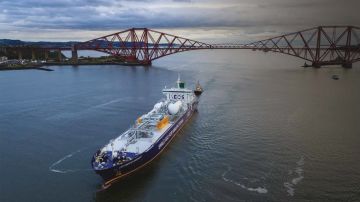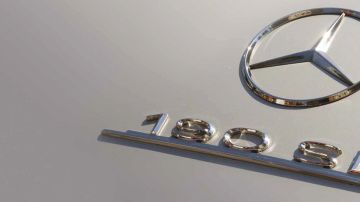The arrival of US shale gas into Britain marks a new chapter in the story of Grangemouth. And it is a story worth telling
A LONE Scottish piper heralded the arrival of the first shipment of US fracked shale gas into Grangemouth.
Bob Lowe, a former INEOS employee, played Skye Boat Song from the bow as the 600ft vessel INEOS Insight – emblazoned with the words ‘Shale gas for manufacturing’ – passed under the Forth Bridge.
For John McNally, CEO INEOS O&P UK, it was a moment to savour as he witnessed history in the making along with about 400 guests including INEOS staff whose names had been drawn from a hat.
“When I took over as CEO in 2014, people were talking about this day then,” he said. “We have literally been counting down the days for the past two years.”
On board the specially-designed ship, which had been built in China, was 27,500 cubic metres of ethane that had been pumped out of the ground more than 3,000 miles away in Pennsylvania and loaded on to the vessel for its 10-day voyage across the Atlantic.
The UK’s Chemical Industries Association described it as the most significant investment in manufacturing in a decade.
“The shipments are not just good news for INEOS,” said Steve Elliott, Chief Executive of the Chemical Industries Association. “It is also good news for the whole of the sector and beyond. By allowing affordable and secure energy into the system as INEOS are taking the lead in doing, we can get manufacturing working at better capacity. This will deliver strong environmental, social and economic benefits for all.”
INEOS’ precious cargo from America will allow British industry to finally take advantage of the cheap US gas which has done so much to revitalise manufacturing in America, and help the UK to compete globally. Across the Atlantic, America’s energy is now so competitive that there are large building programmes in industries such as chemicals and steel, which have suddenly become the most competitive in the world.
“In America so much gas is being produced, that gas import terminals are being converted for exports,” said INEOS Chairman and Founder Jim Ratcliffe.
Jim, who grew up in Failsworth, Manchester, said the arrival of the first US shipment was a hugely important and historic day for both INEOS and the UK.
“Its arrival guarantees the security of thousands of jobs in Scotland,” he said. “Shale gas can help to stop the decline of British manufacturing and today is the first step in that direction.”
It is the first time ethane from US shale gas has been shipped to the UK’s shores and is the culmination of a $2 billion (£1.53 billion) investment by INEOS.
In all, eight tankers will create the virtual pipeline between the US and the UK every week for the next 15 years.
To receive the gas at Grangemouth, INEOS had to invest millions to modernise the 1,700-acre Scottish site. It built a new import terminal so vessels could offload their vital cargo and installed more than three miles of pipelines to transport the gas on its final journey from the port to a new 40-metre high ethane storage tank, the largest of its kind in Europe.
A brand new office block was also built, bringing everyone together for the first time since INEOS bought the site from BP in 2005.
“The impact on Grangemouth will be transformational,” said John. “It will reverse the plant’s fortunes overnight because it will finally be able to run at full capacity.”
The olefins plant has been running at half capacity, leading to huge losses, for many years because of a shortage of North Sea gas which INEOS uses as an essential feedstock.
Without it, INEOS would have been forced to close the loss-making petrochemical plant due to the severe decline of gas from the North Sea.
The closure of the petrochemical complex would have probably also spelled the end of its refinery, which produces the bulk of fuels used in Scotland and contributes about 3% of Scotland’s GDP.
“If you look back at the history of this site we were at times losing over £100 million a year and it was unsustainable,” said John. “Looking forward we expect to be making over £100 million a year if everything is running.”
The crucial element to saving the complex has been the shipments of US shale gas.
“Our shale ‘investment’ has saved 10,000 direct and indirect jobs in Scotland,” said Jim.
But it’s not only INEOS’ site at Grangemouth that will benefit from the shipments.
An historic pipeline built to transport surplus North Sea gas from ExxonMobil’s ethylene plant in Fife to Grangemouth is being reversed so that INEOS can now transport some of its imported gas to ExxonMobil instead.
“The Fife plant plays an important role in the region’s economy,” said Sonia Bingham, Fife plant manager for ExxonMobil Chemical.
A pipeline will also carry ethylene from Grangemouth to INEOS Oxide’s manufacturing plant in Hull so that it can increase its production of ethyl acetate by 100,000 tonnes a year from next year.
Ethyl acetate is in high demand for use in pharmaceuticals, cosmetics, inks and flexible packaging and the Hull plant is already running at full capacity.
That multi-million investment was announced shortly after Britain voted to leave the European Union.
“We believe in British manufacturing and will support it whenever we can,” said Jim.
Graham Beesley, CEO INEOS Oxide, said INEOS Oxide was already the largest producer of ethyl acetate in Europe.
“We are about to get a lot bigger,” he said.


















